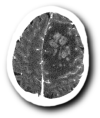Imaging of Cerebral Venous Thrombosis
- PMID: 36013394
- PMCID: PMC9410175
- DOI: 10.3390/life12081215
Imaging of Cerebral Venous Thrombosis
Abstract
Cerebral venous thrombosis is a rare cause of stroke. Imaging is essential for diagnosis. Although digital subtraction angiography is still considered by many to be the gold standard, it no longer plays a significant role in the diagnosis of cerebral venous thrombosis. MRI, which allows for imaging the parenchyma, vessels and clots, and CT are the reference techniques. CT is useful in case of contraindication to MRI. After presenting the radio-anatomy for MRI, we present the different MRI and CT acquisitions, their pitfalls and their limitations in the diagnosis of cerebral venous thrombosis.
Keywords: CT venography; MR venography; MRI; cerebral vein; cerebral venous thrombosis; dural sinus thrombosis; intracranial hypertension; venous stroke.
Conflict of interest statement
Julien Savatovsky received honoraria for lectures and board participation from Bayer Healthcare. The other authors declare no conflict of interest.
Figures
























References
-
- Jianu D.C., Jianu S.N., Munteanu G., Flavius T.D., Brasan C. Ischemic Stroke of Brain. Volume 1. IntechOpen; London, UK: 2018. pp. 45–76.
-
- Ferro J.M., Bousser M., Canhão P., Coutinho J.M., Crassard I., Dentali F., di Minno M., Maino A., Martinelli I., Masuhr F., et al. European Stroke Organization guideline for the diagnosis and treatment of cerebral venous thrombosis—Endorsed by the European Academy of Neurology. Eur. J. Neurol. 2017;24:1203–1213. doi: 10.1111/ene.13381. - DOI - PubMed
Publication types
LinkOut - more resources
Full Text Sources

